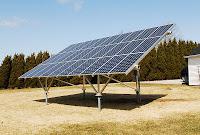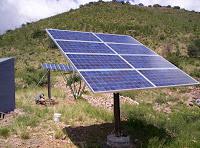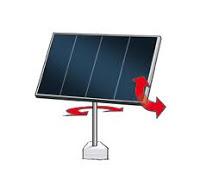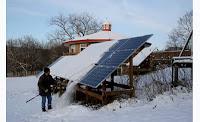Our previous update listed and explained the different types of roof mounts. This update will explain briefly the types of ground mounts and how effective they can be when it comes to harnessing and making the most profit out of your solar exposure.
Ground Mounts: A ground mounted solar system simply is one that the panels are secured in place by the use of racks and frames or other material and firmly attached to the ground surface. This 'panel system' of arrangement can hold up to 20 panels on a single rack or pole depending on the mount. These structures are designed and built to resist very strong winds and even 50 mph hail stones. They usually require a substantial isolated area for the system, for optimum exposure to sunlight, and for security or protection. You wouldn't want your kids playing around one of these - not that they are unstable structures but because like any power generating equipment we want to be safe than sorry.
There are two main types of ground mounted solar systems, at least for residential and small commercial installs:
1) Panel Mounted Systems: This system gives the most 'bang on the buck' for a property owner. It's typical in that the panels are attached on racks and secured to a foundation usually made of concrete. Substantial isolated areas as noted above can mean any where from 1 acre to 10,000 acres. These systems make the most out of any available space by maximizing efficiency with electric output.2) Pole Mounted Systems: This is when the panels on a rack are attached to a pole. The pole is then secured firmly to the ground by insertion into concrete. This mount is mostly used in areas with not so smooth terrains or areas with lots of scrubs or bushes. - Tracking Mechanisms: This is were the property owners can be creative. It involves including a tracking mechanism with the ground installation that follows the sun as it moves across the sky. Now remember most solar installs are static, by making the panels follow the sun from sunrise to sunset the system produces the biggest returns especially in net metering.Ground mounted systems are highly beneficial in that they are easy to maintain. To clean them for example, all you have to do is rinse with water to remove debris and dust or use a plastic shovel to clear snow. When dealing with an engineering issue it becomes very easy for the engineer to move around and examine the system making it easy to spot and work the problem. It also keeps the problem of voiding roof warranties at bay as no connection between the system and the roof is involved.




